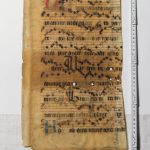Maculatura: septem epistolae Germanicae et Polonicae: detruncatae, probabiliter ab episcopo Johanne Trebirensi scriptae 1586–1588 missae; duo ex Austerliz, una ex Poznanie.
The three antiphoner fragments (F 679, 680, 682) from the same codex, written in a typical Bohemian notation, preserve parts from the rhymed office of St Martha (hospita Christi). Two of the three truncated folios in the mother codex are in immediate succession: the fifth antiphon of the Lauds (Iesus coram populo) begins on the verso of F 680 and ends on the recto of F 682. On the third fragment (F 679), the opening chant of the historia (Iucundetur in hoc solemnio) is legible. The historia Iucundetur written in honour of Martha is known only from Bohemian sources. The liturgical veneration of Martha spread in Bohemia in the 30s of the 14th century, at the initiative of Jan z Dražic, bishop of Prague. The bishop was in exile at the court of Pope John XXII in Avignon from 1318 to 1329, and it is there that he probably became acquainted with the cult of Martha, which flourished in Southern France. After his return, the cult also flourished in Bohemia, and the veneration of the hospita Christi was crowned with proper chants (cf. Zsuzsa Czagány, Historia de sancta Martha Hospita Christi redactio Bohemica. Ein spätmittelalterliches Reimoffizium in seiner böhmischen Überlieferung. Wissenschaftliche Abhandlungen, series HISTORIAE 65/9, The Institution of Mediaeval Music, Ottawa, 2004). The chant series is most probably the work of a Bohemian author: although its texts were widely known, its melodies survive only in Bohemian codices. Three of our fragments preserve these “Bohemian” melodies. Thus, in addition to the notation, the content of the fragments clearly confirms that the late mother codex was an antiphoner of Bohemian origin.
Before the chants from the historia Iucundetur, the recto of fragment F 679 preserved the final part of another office. The chants, which are difficult to disentangle, presumably belonged to the second Vespers of a historia of Anne (26 July), the feast that immediately preceded Martha (29 July) in the calendar. The top line preserves the final text line of the verse of a responsory in mode 5 (F-mode) and the almost complete doxology. The text refers to the verse Est haec virga Dei (Est haec virga Dei mater flos ortus ab illa, the section in bold appears on the fragment), which in Hungarian sources belonged to the responsory Inclita stirps Iesse virgam (Responsories, 2126). However, the melody in mode 2 is far from resembling the melody in mode F of the fragment. The rubric recording the hymn and versicle is followed by the Magnificat antiphon of the Vespers Caeleste beneficium. The antiphon is well known in all three Hungarian rite areas (cf. CAO-ECE V Strigonium/Sanctorale, Budapest: MTA Zenetudomány Intézet, 2002, 115-116, 138; CAO-ECE VI Kalocsa-Zagreb/Sanctorale, Budapest: MTA Zenetudomány Intézet, 2008, 88-89; CAO-ECE VII Transylvania-Várad, Budapest: MTA Zenetudomány Intézet, 2010, 94-95), and is also recorded in the Hungarian notated sources (MMMAe V Antiphonen, 1053). The first mode melody notated in these, however, again differs from the fragment’s most probably mode 3 melody. The verso of the fragment, before the opening of the Martha office, presumably contains a blurred torso of the text of the last chant (a Magnificat antiphon?) of the Anna office, presumably a single word. This piece has not yet been identified. On the basis of what we have learned so far, we assume that an unknown musical redaction of a known Anna historia has survived on the Bohemian fragment, which deserves further research based on a wider range of mainly Bohemian sources.
Zsuzsa Czagány



